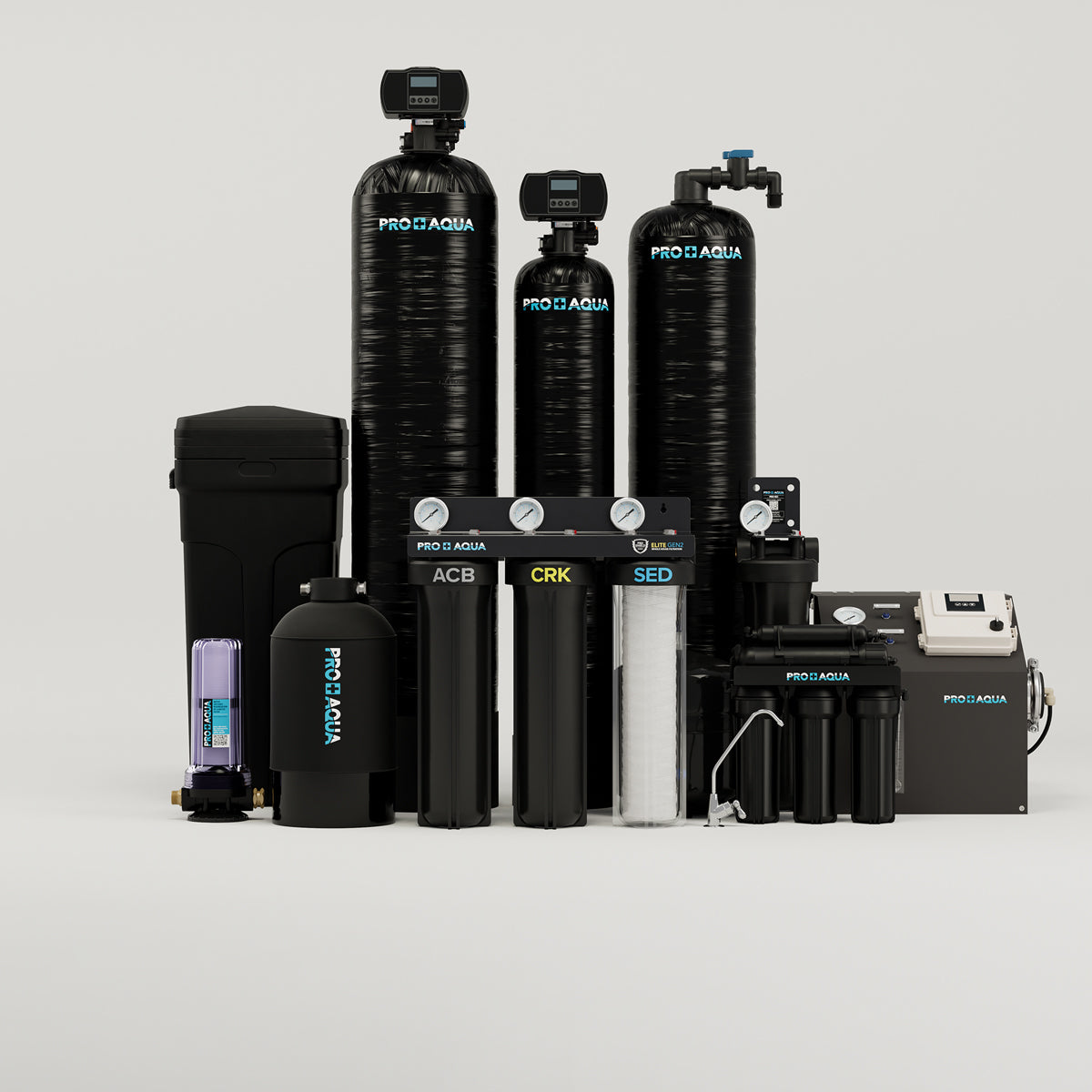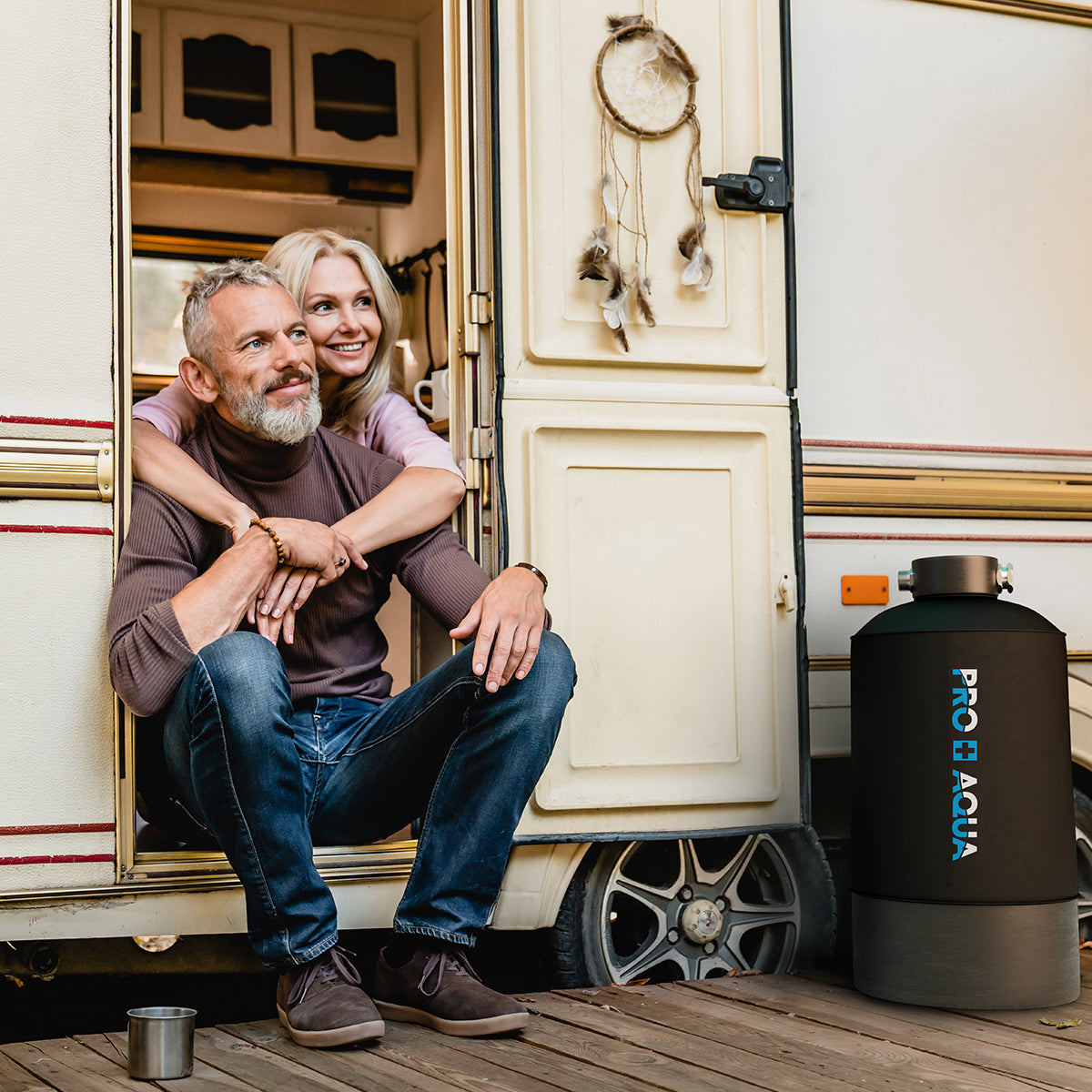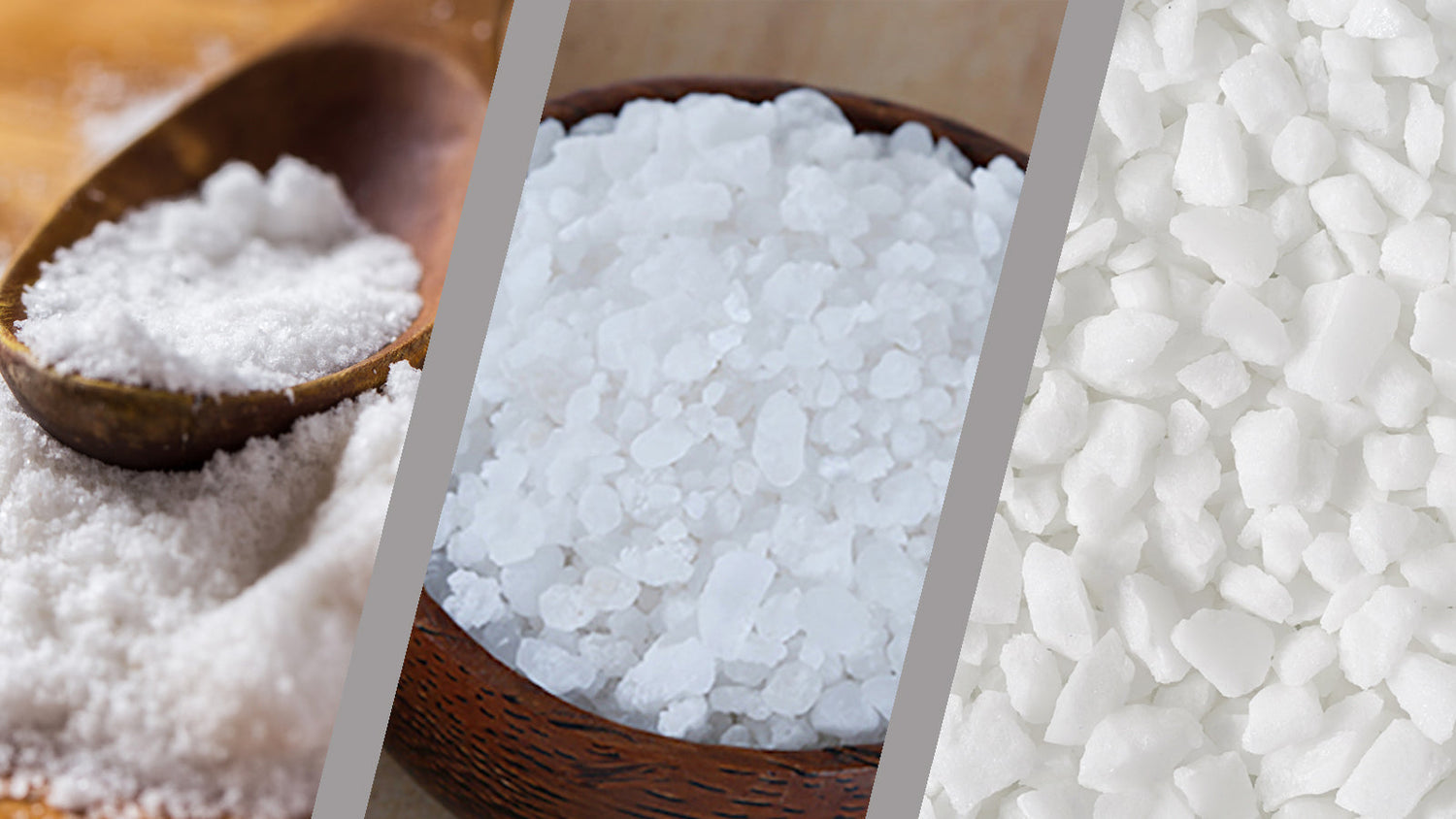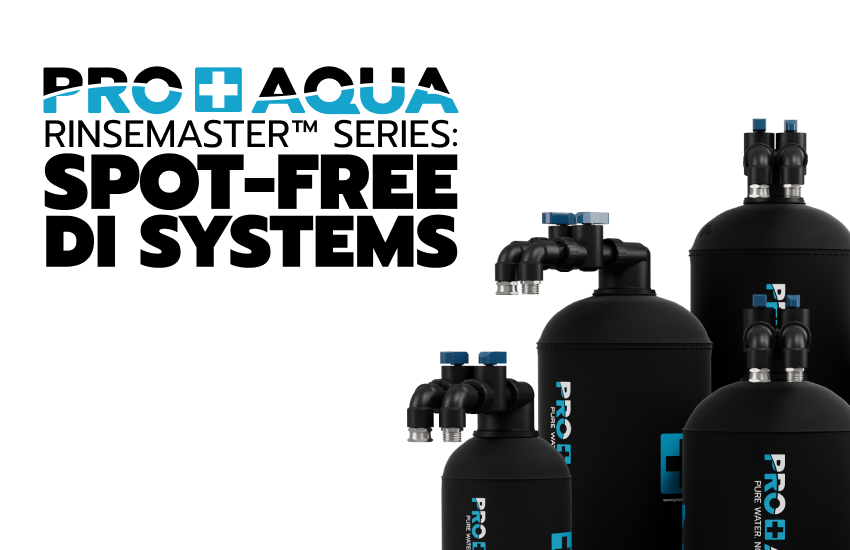
When it's time to regenerate your PRO+AQUA RV Portable Water Softener, choosing the right salt is important for protecting your resin bed and future soft water supply. To start—you'll need a Regeneration Kit and some salt, but what kind of salt should you use?
There are a variety of salts available in most grocery stores, these include table salt, Himalayan pink salt, kosher salt, and sea salt, just to name a few.
Not only do they differ in taste and texture, but also in mineral and sodium content. Don’t forget that the price of salt can range from a few cents per pound all the way up to $10 per pound.
Why You Need the Right Salt for Regenerating an RV Water Softener
Regenerating your RV water softener removes hard minerals like calcium and magnesium from the resin bed, restoring its ability to soften your water. Using the right salt ensures you get the best performance and longest lifespan from your softener.
Our team tested three common options for RV softener salt: plain salt, sea salt, and 'Morton Clean and Protect Water Softener Salt' pellets. See which is the best type of salt to use on an RV Water Softener.
How We Tested RV Water Softener Regeneration Salt
We used the PRO+AQUA Travel Series Portable Water Softener, which has a 2,000-gallon capacity between regenerations. This softener had been used for months for RV showers, laundry, auto detailing, carpet cleaning, and pressure washing. We knew that it would quickly reach the threshold for a full regeneration.
For each regeneration performed, we set the timer for 45 minutes. The water flow coming out of the softener was slowed down so the size of the stream would be about the same as a pencil. To regenerate, we used the PRO+AQUA Regeneration Kit and filled it up with salt all the way to the top.
Below we’ll rank them based on the amount of soap lather and how effective each salt was in regenerating the softener by giving it a "PRO SCORE" from 1-10 (10 being the best).
Salt #1: Plain Salt
- Price: $0.48/lb (Walmart)
- Performance: Plain salt dissolved quickly, giving the resin less contact time with the brine solution. It still produced soft water with decent lather and feel.
- Pros: Affordable, easy to find
- Cons: Quick dissolve reduces resin exposure to brine
The first type of salt we used was plain from Walmart, they sell it for $0.48 per pound. We bought 2lbs and emptied the contents into the regen kit. We installed the kit onto the Travel Series and let it run its COARSE (get it?) for 45 minutes.
Though the plain salt did a decent job at regenerating the resin, we didn’t like how quickly it dissolved in the regen kit. The way we look at it, the longer the resin is exposed to brine, the better of a job it will do in making sure it cleans the resin of the contaminants stuck to it. Nonetheless, plain salt regenerated the softener and it was producing soft water by the time it was complete.
PLAIN SALT PRO SCORE: 8/10
Salt #2: Sea Salt
- Price: $1.30/lb (Grocery store)
- Performance: Sea salt dissolved quickly but did not regenerate the resin effectively. Within two weeks, hard water returned, soap scum increased, and lather was poor.
- Pros: Readily available
- Cons: Trace minerals can clog resin beads, short regeneration lifespan
At the next round of regeneration, we opted for Sea Salt. This cost us $1.30 per pound at the local grocery store. We didn’t really have any expectations with Sea Salt, we figured, salt was, salt. The grain size of the sea salt was bigger than the plain version. However, once it was placed inside the regen kit, it dissolved just as fast as the plain. When it came to the results after 45 minutes, the water felt like the water from using plain salt.
BUT! Within two weeks of regular use of the water softener, the resin needed to be regenerated again. How do we know this? We went by feel and how well the water would lather up soap. At the end of two weeks, the water coming out of it was just like city water, hard. It wasn’t slippery or possessed that softer feel. There was also a noticeable amount of soap scum around the sink, which only means that minerals were not being trapped by the resin.
SEAL SALT PRO SCORE: 5/10
Salt #3: Morton Clean and Protect Water Softener Salt
- Price: $5.96 for a 40lb bag (Walmart)
- Performance: Water softener pellets took longer to dissolve (about 75 minutes total) but delivered the best results. Soft water felt slippery, and the resin stayed clean longer.
- Pros: Most effective regeneration, cost-effective long term
- Cons: Bulk storage, longer regeneration time
For this test, we headed back to Walmart and bought ourselves a 40lb bag of Morton Clean and Protect Water Softener Salt for a low price of $5.96 per bag. We filled up the regen kit with the Morton pellets and began the regeneration and set the time for 45 minutes. However, after that time frame, we noticed that housing for the regen kit still had pellets in it. So we let it run another 15 minutes and at that time, the pellets were much smaller. Another 15 minutes and the pellets were finally gone.
We did our lather test and found that the water coming out of the softener was indeed soft, plus it had a great slippery feel to it, exactly how soft water is supposed to be. Clearly, the pellets did a great job with regeneration, the only issue was how long it took to do so. But then again, the time it took to regenerate, an hour and 15 minutes, could have been what made it work so well since the resin was exposed to the brine at a longer rate.
MORTON SALT PRO SCORE: 10/10
Key Takeaways: Best RV Water Softener Salt
| Salt Type | Pro Score | Best For |
|---|---|---|
| Morton Softener Pellets | 10/10 | Best overall performance, long-lasting |
| Plain Salt | 8/10 | Budget-friendly, space-saving |
| Sea Salt | 5/10 | Not recommended for RV softeners |
When it comes to regenerating your portable RV water softener, dedicated water softener salt pellets are your best bet for maximizing resin lifespan and water softness.
Plain salt works in a pinch but isn’t as effective long term.
Sea salt is the least effective and can introduce unwanted trace minerals.
Final Thoughts: Save Money & Keep Your Water Soft
From our experience, the sea salt was the one that performed the worst. Perhaps it’s because sea salt is produced through the evaporation of ocean water and water from sea lakes. Which leaves behind trace minerals such as magnesium, calcium, and potassium in trace amounts, depending on the water.
This situation is rather ironic since those are the same minerals that the resin binds with to make soft water. With that in mind, it’s safe to assume that the trace minerals may have clung onto the resin beads during regeneration, which made them impacted, which required another regeneration session much sooner.
Lastly, when we tested Morton’s Salt Pellets, the results were very good. It makes sense since that’s what is normally used in regular-sized water softeners. But there are two challenges that come up with using pellet salt. 1. 40lbs of salt, and, 2. the time it takes to regenerate.
These “challenges” aren’t really all that bad. Think about it, the 40lbs of salt only cost $5.96 per bag at Walmart. For that same price, you’d only get 6lbs of plain salt. If you can put up with storing the rest of that salt somewhere in your home, then it really isn’t a problem, if anything you’re saving money in the long run. Secondly, the length of time it takes to regen isn’t all that bad considering that the longer the resin is exposed to brine, the cleaner it gets.
Power Rankings
If we were to rank each of these salts based on how effective they are, here’s how they would rank from best to last:
- Morton Clean and Protect Water Softener Salt: The most cost-effective of the three. Though it took a little longer to complete the regen, it did a great job in cleaning the resin bed, making the water very soft.
- Plain Salt: If space is limited for storing salt, using the plain version is going to be your best bet. At the cost of $0.48/pound, it still remains very affordable.
- Sea Salt: This type of salt cost more and didn’t work that well. The regeneration effect only lasted about 2 weeks.
If you’re new to RV life, remember that regular regeneration with the right salt will keep your softener performing at its best. Buy your salt in bulk, store it safely, and enjoy spot-free dishes, soft hair, and scale-free appliances wherever you roam.
Ready to regenerate your softener? Shop the PRO+AQUA RV Regeneration Kit now!







Leave a comment
This site is protected by hCaptcha and the hCaptcha Privacy Policy and Terms of Service apply.